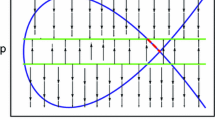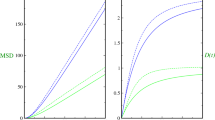Abstract
We report an efficient approach to accurately and efficiently compute transmission probabilities in resonant deep tunneling regime. Dynamical systems subjects to this phenomenon prove hard to simulate numerically even with exact methods, which motivates new methodological developments owing to the impact resonant phenomena have in several processes such as chemical reactions and electronic transport. Our approach is based on the original reformulation of stationary quantum scattering as the propagation of a quantum trajectory in extended phase space. The present paper discusses in detail the node problem occurring to the time-independent quantum trajectory method in this very challenging situation, and introduces an efficient semi-analytical node-skipping scheme to circumvent expensive numerical integration in their vicinity. We illustrate how this numerical extension allows to treat all regimes of quantum tunneling with great versatility by comparison to existing approaches of the litterature. The quantum trajectory, thus, represents a very promising tool for the study of complex chemical reactions characterized by resonant tunneling effect.






Similar content being viewed by others
Data Availability
No data associated in the manuscript
Notes
Application of the present approach to potentials lacking such property showed [17] that in practice, the method keeps its potency when the condition is not met.
The R index, which refers to the right asymptotic x-position, should not be confused with the reflection coefficient R(E).
As discussed in other work [14], the trajectory propagation time through a region of space, independent of the time translation, is meaningful and related to the integrated density over that region.
References
P.R. Schreiner, Quantum mechanical tunneling is essential to understanding chemical reactivity. Trends Chem. 2(11), 980 (2020)
P. Harrison, A. Valavanis, Quantum Wells, Wires and Dots: Theoretical and Computational Physics of Semiconductor Nanostructures (Wiley, New York, 2016)
W.H. Miller, Semiclassical limit of quantum mechanical transition state theory for nonseparable systems. J. Chem. Phys. 62(5), 1899 (1975)
W.H. Miller, Path integral representation of the reaction rate constant in quantum mechanical transition state theory. J. Chem. Phys. 63(3), 1166 (1975)
J.O. Richardson, Perspective: ring-polymer instanton theory. J. Chem. Phys. 148(20), 200901 (2018)
R.J. Le Roy, K. Quickert, D. Le Roy, Permeability of one-dimensional potential barriers. Trans. Faraday Soc. 66, 2997 (1970)
R.D. Levine, Quasi-bound states in molecular collisions. Acc. Chem. Res. 3(8), 273 (1970)
R. Levine, S.-F. Wu, Resonances in reactive collisions: computational study of the H + H\(_2\) collision. Chem. Phys. Lett. 11(5), 557 (1971)
L. Chang, L. Esaki, R. Tsu, Resonant tunneling in semiconductor double barriers. Appl. Phys. Lett. 24(12), 593 (1974)
L. Berman, U. Peskin, Short-time calculations of resonant tunneling probabilities by the flux-averaging method. Chem. Phys. Lett. 360(3–4), 374 (2002)
B. Poirier, Bohmian mechanics without pilot waves. Chem. Phys. 370(1), 4 (2010) (Dynamics of molecular systems: from quantum to classical)
J. Schiff, B. Poirier. Communication: quantum mechanics without wavefunctions. J. Chem. Phys. 136(3), 031102 (2012)
G. Parlant, Y.-C. Ou, K. Park, B. Poirier, Classical-like trajectory simulations for accurate computation of quantum reactive scattering probabilities. Comput. Theor. Chemi. 990, 3 (2012) (Chemical reactivity, from accurate theories to simple models, in honor of Professor Jean-Claude Rayez)
L. Dupuy, G. Parlant, B. Poirier, Y. Scribano, Direct and accurate calculation of dwell times and time delays using quantum trajectories. Phys. Lett. A 456, 128548 (2022)
S. Mandrà, S. Valleau, M. Ceotto, Deep nuclear resonant tunneling thermal rate constant calculations. Int. J. Quantum Chem. 113(12), 1722 (2013)
C.-C. Chou, R.E. Wyatt, Computational method for the quantum Hamilton-Jacobi equation: bound states in one dimension. J. Chem. Phys. 125(17), 174103 (2006)
Y. Scribano, G. Parlant, B. Poirier, Communication: adiabatic quantum trajectory capture for cold and ultra-cold chemical reactions. J. Chem. Phys. 149(2), 021101 (2018)
C.-C. Chou, R.E. Wyatt, Computational method for the quantum Hamilton-Jacobi equation: one-dimensional scattering problems. Phys. Rev. E 74(6), 066702 (2006)
W.R. Inc., Mathematica, Version 13.2, Champaign, IL (2022)
D. Babyuk, R.E. Wyatt, Coping with the node problem in quantum hydrodynamics: the covering function method. J. Chem. Phys. 121(19), 9230 (2004)
D. Babyuk, R.E. Wyatt, Application of the covering function method in quantum hydrodynamics for two-dimensional scattering problems. Chem. Phys. Lett. 400(1–3), 145 (2004)
T. Seideman, W.H. Miller, Quantum mechanical reaction probabilities via a discrete variable representation-absorbing boundary condition Greens function. J. Chem. Phys. 97(4), 2499 (1992)
T. Seideman, W.H. Miller, Calculation of the cumulative reaction probability via a discrete variable representation with absorbing boundary conditions. J. Chem. Phys. 96(6), 4412 (1992)
G.C. Schatz, A. Kuppermann, Role of direct and resonant (compound state) processes and of their interferences in the quantum dynamics of the collinear H + H\(_2\) exchange reaction. J. Chem. Phys. 59(2), 964 (1973)
J.A. Kaye, A. Kuppermann, Collision lifetime matrix analysis of the two lowest energy resonances in the collinear H + H\(_2\) system. Chem. Phys. 127(1–3), 97 (1988)
S.D. Chao, R.T. Skodje, Time delay as a tool to identify the signatures of reactive resonance: F + HD and F + H\(_2\) reactions. J. Chem. Phys. 119(3), 1462 (2003)
V. Aquilanti, S. Cavalli, A. Simoni, A. Aguilar, J.M. Lucas, D. De Fazio, Lifetime of reactive scattering resonances: Q-matrix analysis and angular momentum dependence for the F + H\(_2\) reaction by the hyperquantization algorithm. J. Chem. Phys. 121(23), 11675 (2004)
K. Takahashi, M.Y. Hayes, R.T. Skodje, A study of resonance progressions in the F + HCl \(\rightarrow\) Cl+ HF reaction: a lifetime matrix analysis of pre-reactive and post-reactive collision complexes. J. Chem. Phys. 138(2), 024309 (2013)
J. Gezelter, W. Miller, Resonant features in the energy dependence of the rate of ketene isomerization. J. Chem. Phys. 103 (1995)
J. Schiff, S. Shnider, A natural approach to the numerical integration of Riccati differential equations. SIAM J. Numer. Anal. 36(5), 1392 (1999)
S. Mandrà, Deep nuclear resonant tunneling thermal rate constant calculations [Doctoral Dissertation, Università degli Stugli di Milano] (2013)
Acknowledgements
This work has been supported by the Agence Nationale de la Recherche (ANR-HYTRAJ), Contract No. ANR-19-CE30-0039-01. Y.S. and L.D. thank support from the High Performance Computing Platform MESO@LR at the University of Montpellier. Authors would like to thank B. Poirier and G. Parlant for fruitfull discussions.
Author information
Authors and Affiliations
Corresponding author
Appendices
A. Relating Noether momentum to local transmission/reflection coefficients
We give below the straightforward but tedious derivation of the set of Eq. (15). In accord of the physical interpretation of local transmission/reflection coefficients, and the use we make of derived formula in the free particle limit, we assume the potential, wave vector, and local coefficients are constants in a small radius around x. This allows us to simplify the wavefunction decomposition to:
with \({\tilde{v}} = \hbar {\tilde{k}} / m\). All functions f(x) taken as constant in the immediate vicinity of x are noted \(\tilde{f}\). See the main text for the definition of each quantity. Now turning to the definition of Noether momentum,
We make the use of the bijection between time and space, \(\displaystyle \frac{\textrm{d}}{\textrm{d}t} = \dot{x} \frac{\textrm{d}}{\textrm{d}x}\) and of the link between trajectory speed and wavefunction density Eq. (2) to re-express p. Additionally, for clarity, we introduce the following notation:
First manipulations read:
Upon rearrangement, we have:
From the conservation of the transmitted current, we have \(|T(E)|^2 = |\tilde{{\mathcal {T}}}|^2-|\tilde{{\mathcal {R}}}|^2\); thus, we obtain
The last line shows that requiring k, \({\mathcal {R}}\) and \({\mathcal {T}}\) to be constant also makes p constant. We, thus, adopt the notation \(\tilde{p}\). Replacing successively \(|\tilde{{\mathcal {R}}}|\) and \(|\tilde{{\mathcal {T}}}|\) using \(|T(E)|^2 = |\tilde{{\mathcal {T}}}|^2-|\tilde{{\mathcal {R}}}|^2\) again, we can thus write
The set of Eq. (15) directly follows from the above formula. From a purely numerical standpoint, it is seen that if p varies by an negligible amount compared to \(\hbar \tilde{k}\), then the local coefficients will not vary appreciably and the relation will hold.
B. Complex momentum approach with Mobius scheme
It is based on a different functional form for the wavefunction, using a complex phase W(x):
Inserting this exponential form in Schrödinger’s equation yields a differential equation for the complex momentum defined as \(\displaystyle {\mathcal {P}}(x)=\frac{\partial W}{\partial x}\):
Similar to our method, the boundary condition on the transmitted side is straightforward to compute, corresponding to a classical limit:
The numerical propagation is, hence, initialized on the transmitted side and propagated backwards to the incident asymptote. The reflection probability amplitude can then be evaluated using:
The wavefunction being encoded in the complex momentum, there is a simple link between its real and imaginary parts on one hand and the complex phase space (r, s) of our quantum trajectories:
It is obvious that the complex momentum will suffer the same propagation problem across a pseudo-node than our trajectory’s variables, and in fact much worse. Indeed, the imaginary part of \({{\mathcal {P}}}\) will suddenly change sign to very high absolute values because it involves both r and s. To remedy this, Chou and Wyatt took advantage of the peculiar structure of their differential equation, which is of the generalized Riccati type. Indeed, once the momentum derivative is isolated,
it is clear it has the following form:
with \(\displaystyle \alpha (x) =\delta (x)=0\), \(\beta (x)=2im[E-V(x)] /\hbar\) and \(\gamma (x) = -i/\hbar\).
To integrate this type of equation numerically in presence of discontinuities, Schiff & Schnider introduced a very powerful tool: Möbius schemes [30] built upon a geometrical picture of Riccati’s equation as a singularity-free Grassmanian flux. Using a Möbius scheme as a propagator, the known value of solution \(y_i=y(x_i)\) at one position is used to compute the next value \(y(x_i+h)=y_{i+1}\) as:
The exact form of the factors with tildes appearing in the above equation depends on their corresponding symbols in Riccati’s equation and the order in h to which Möbius scheme is expanded. We refer the reader to the original publications for more details.
C. ODE-\(\Psi\) approach
Mandrà et al. [15, 31] considered numerically challenging potential profiles subject to resonant tunneling by propagating both the complex wavefunction \(\Psi (x)\) and its first derivative \(\displaystyle \Psi '(x) = \frac{\textrm{d}}{\textrm{d} x} \Big [ \Psi (x) \Big ]\) using the following system of equations:
As done in our approach and that of Chou and Wyatt, boundary conditions corresponding to the transmitted asymptote are used to start the propagation. The normalization they use differs from the one used for quantum trajectories, hence why it is denoted as \(\Psi (x)\) rather than \(\psi (x)\) in this paper.
with \(\displaystyle v(x) = \sqrt{2\,\frac{E-V(x)}{m}}\) and \(\displaystyle k(x) = \frac{m v(x)}{\hbar }\). Initial conditions thus are
and the propagation is done starting from the transmitted asymptote into the incident one. Once it has ended, the transmission probability is extracted from the final values of the two complex variables:
Rights and permissions
Springer Nature or its licensor (e.g. a society or other partner) holds exclusive rights to this article under a publishing agreement with the author(s) or other rightsholder(s); author self-archiving of the accepted manuscript version of this article is solely governed by the terms of such publishing agreement and applicable law.
About this article
Cite this article
Dupuy, L., Scribano, Y. Coping with the node problem in resonant scattering simulations using quantum trajectories: an efficient and accurate combined analytical-numerical scheme. Eur. Phys. J. Spec. Top. 232, 1871–1883 (2023). https://doi.org/10.1140/epjs/s11734-023-00924-3
Received:
Accepted:
Published:
Issue Date:
DOI: https://doi.org/10.1140/epjs/s11734-023-00924-3




